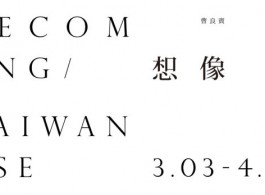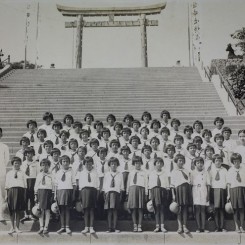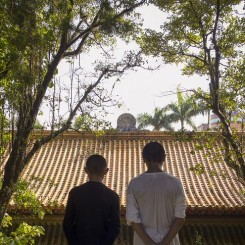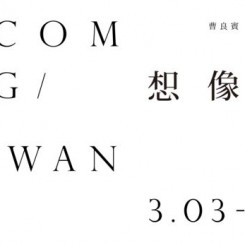“Becoming/Taiwanese”
TKG+ Projects
Over 300 years Taiwan had been ruled by foreign regimes which cunningly through warfare and diplomacy acquired the right to rule the island, where the act of public pillage, economic rapine, cultural ravishment, even ethnic plundering, was undertaken. And this contributes largely to the lingering Taiwanese sentiment of an oversea colonial motherland. History has cultivated Taiwan’s cultural and ethnic landscape. Despite the lift of martial law in 1987 and the right to freedom of thought that ensued, Taiwan’s sovereignty remains a haunting question.
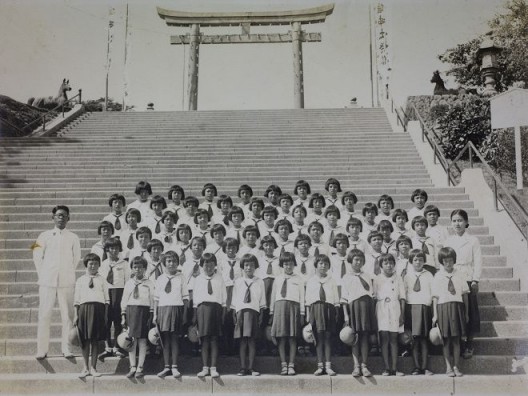
曹良宾,《高雄神社》,双面 LED 灯箱与灯片,90 x 120 cm,1940(图片提供:艺术家与TKG+ Projects)
Liang-Pin Tsao, Takao Shrine, 2016. Two-sided LED lightbox with backlit transparency, 90 x 120 cm.(Courtesy of the artist and TKG+ Projects)
Liang-Pin Tsao: Becoming/Taiwanese pivots around Martyrs’ Shrines across the island. Capturing the Martyrs’ Shrines through photography, the artist then transfers the imagery along with archival images of the Shinto shrines onto light boxes, juxtaposed with historical documents, in an attempt to foreground the past relationship between Taiwan and Japan. The existing Martyrs’ Shrines in Taiwan, revamped from Shinto shrines of the Japanese rule period, embody the once conflicted relationship between China and Japan, and bear witness to Taiwan’s fragmented perception of identity, tormented by its colonial past over a hundred years ago. Historically nationalist worship systems are not uncommon. As early as the Qing dynasty, Zhao Zhong Shrines or Yimin Temples (yimin meaning righteous people) had been founded to commemorate martyrs. However, the Martyrs’ Shrine of China or the Shinto shrine of Japan, more than simply a place of commemoration and worship, was the then-ruling regime’s means to obliterate existing history or redistribute economic resources, through the construction of a sacred place of worship, or the implementation of a new education system or language, infiltrating a new political system and nationalist identity into people’s everyday life.
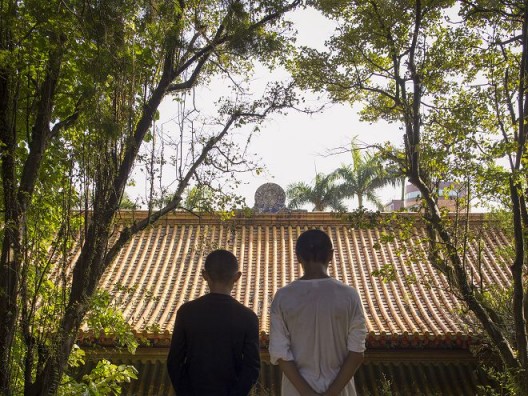
2. 曹良宾,《基隆忠烈祠》,双面 LED 灯箱与灯片,90 x 120 cm,2016(图片提供:艺术家与TKG+ Projects)
Liang-Pin Tsao, Keelung Martyrs’ Shrine, 2016. Two-sided LED lightbox with backlit transparency, 90 x 120 cm. (Courtesy of the artist and TKG+ Projects)
The artist interviewed tourists who were sightseeing and taking photographs at different Martyrs’ Shrines around Taiwan. He realized that the Martyrs’ Shrine no longer holds any nationalist significance to tourists, because the public’s perception of history and national identity after the lift of martial law has shifted drastically away from the authoritarian governance framework; meanwhile, the state’s hero worship mechanism has been replaced by consumer culture. For tourists, the historic and architectural heritage of the Shinto shrine is more arresting than the traditional significance of the Martyrs’ Shrine as the sacred place of hero worship. At the same time, the promotional materials in the shrine have been changed to visitors’ guides for tourism purposes. Even though the shrine has ceased to function as a political means to rule people, the state power continues to glorify within the walls of the shrine the “national revolutionary martyrs,” “fallen soldiers of the Sino-Japanese War,” and “anti-Japanese martyrs,” or those who were irrelevant or controversial in Taiwanese history. The state power that once instigated a national identity propaganda remains in place. Pondering the issue of transitional justice, the artist prompts the viewer to think about how to break free from the traditional authoritarian shackles, and about the abolishment, the preservation, or the transformation of the Martyrs’ Shrine, in an attempt to not only commemorate these martyrs’ sacrifice and educate the public about the historic lesson, but also rid the shrine of its function as the authoritarian means to instigate nationalist sentiment.
The Chinese exhibition title Xiang Xiang Zhi Suo, a direct translation of “imaginarium,” responds to the artist’s investigation of an imagined Taiwan’s subjectivity and identity. Inspired by the book Imagined Communities: Reflections on the Origin and Spread of Nationalism (1983) by the late American historian Benedict Anderson, the artist names the Shinto/Martyrs’ shrine “imaginarium” with an understanding that nationalism is never easy to define, that it is a collective consensus, that it belongs to distinguishable groups of people. He sees the Shinto/Martyrs’ shrine as a testament to the state’s manipulation of people’s imagined history through cultural dominance, as well as a sacred space that cradles cultural heritage and nurtures vigorous imagination.
“Becoming/Taiwanese,” the English title of the exhibition, is also the name of the photography project. By juxtaposing “Becoming” and “Taiwanese,” the artist contemplates the fluid definition of “Taiwanese” in his examination of the island’s colonized history for the past 300 years. The artist reflects on the education he and so many others have received under the one-party state, as well as their frustration and shame upon learning a different perspective on history after the lift of martial law. The vestiges of the past
loiter in the collective subconsciousness, furtively shaping Taiwanese identity and the relationship between “us” and “others.”
About the artist
Born and raised in Taiwan, Liang-Pin Tsao is an artist based in Taipei, Taiwan. He holds an MFA degree from Pratt Institute, and his works have been exhibited internationally. Liang is the recipient of New York Residency Program sponsored by the Ministry of Culture Taiwan, Pak-Hing Kan Arts Grant, and scholarship from Pratt Institute among others. His recent works investigate the relational tension between national history, individual identity and value awareness, exploring its socio-cultural significance.
Liang also devotes himself to educational and curatorial affairs, and has conducted many lectures, workshops and curations at Taipei Fine Art Museum, Museum of Contemporary Art Taipei, Taipei Artist Village, etc. He has initiated a symposium project, PHOTO TALKS, since 2015 to help promote contemporary photography in Taiwan. In 2016, he establishes Lightbox Photo Library, a non-for-profit organization supported by National Culture and Arts Foundation and Ministry of Culture, which is free and open to all, and employed as a method to cultural autonomy and freedom of knowledge.
Rongda WEI

